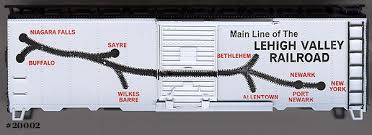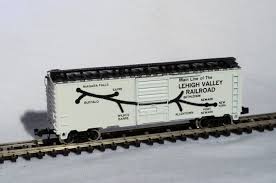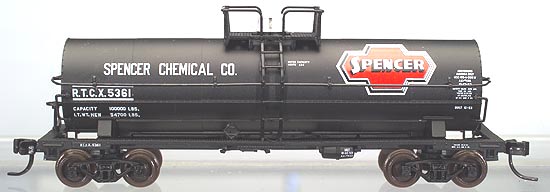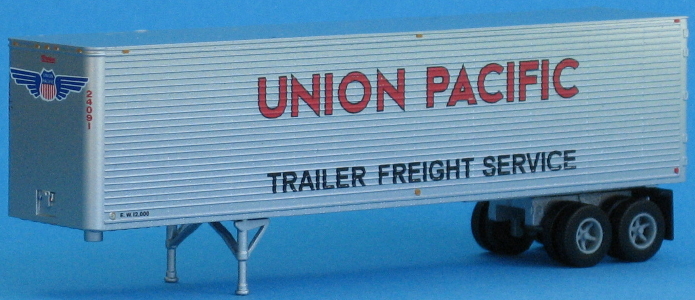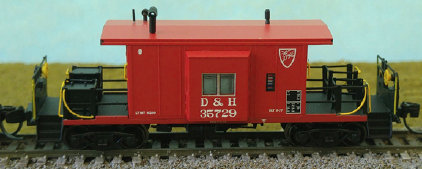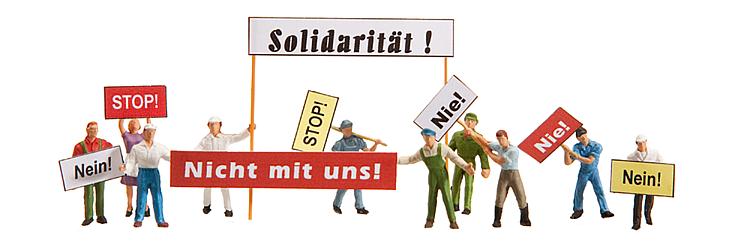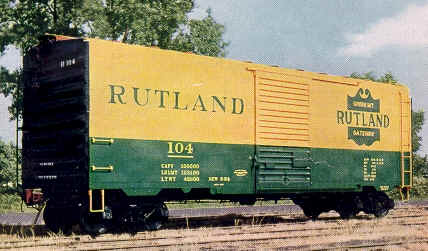Specific Item Information: This is a model of an actual car owned by the Lehigh Valley Railroad and spotted for advertising at South Plainfield, NJ.
The Lehigh Valley "Main Line of...System Map" 40' Steel Boxcar stock number 20002 (HO), was released by Bev-Bel in January of 1999 as the second in the Millenium Series of unique and special release rolling stock. This extremely limited production run sold out in a very short time. As is true with the prototype, this Lehigh Valley 40' Steel Boxcar was released in the only car number which existed in this one-of-a kind scheme. The previuos versions of this car ( stock numbers 326, 326-1 and 326-2) were run without car numbers and with all black printing. Further research of prototype photographs reveal that this car did have end numbers only, was painted with white sides, black roof and ends, and had black printing for the railroad name and route map, with the city names printed in red. This car was produced by Collectors Corner for the Bev-Bel Corp. with all new artwork, correctly painted and printed as per the protoype.
The Lehigh Valley "Main Line of...System Map" 40' Steel Boxcar stock number 20002 (HO), was released by Bev-Bel in January of 1999 as the second in the Millenium Series of unique and special release rolling stock. This extremely limited production run sold out in a very short time. As is true with the prototype, this Lehigh Valley 40' Steel Boxcar was released in the only car number which existed in this one-of-a kind scheme. The previuos versions of this car ( stock numbers 326, 326-1 and 326-2) were run without car numbers and with all black printing. Further research of prototype photographs reveal that this car did have end numbers only, was painted with white sides, black roof and ends, and had black printing for the railroad name and route map, with the city names printed in red. This car was produced by Collectors Corner for the Bev-Bel Corp. with all new artwork, correctly painted and printed as per the protoype.
Model Information: This tooling was introduced by Atlas in 1976. It replaced the earlier (and very similar) model from Roco of Austria that had been imported by Atlas from 1967 until 1975. Initial production was at the New Jersey factory. Production was later moved to China. As of 2017, this model is now very long in the tooth, so recent releases have been classified as 'Trainman' (budget) product line. Newer versions come equipped with Accumate couplers. This model should not be confused with the much newer 'Master' PS-1 boxcar from Atlas which is a completely different tooling.
Similar to other Atlas models of the 1970s and 1980s, this tooling originally featured Rapido Couplers and deep-flange nickel-silver plated wheels. When production moved to China, they started appearing with plastic low-profile wheels and Accumate couplers.
Sometime after 2005, Atlas created a 'Master' version of this model, and downgraded this tooling to the "Trainman" line. The new tooling was a complete redo of the model and has body mounted couplers, metallic wheels and excellent detailing, especially of the underframe. Since these are also marketed as 'PS-1' boxcars, it can be confusing. That tooling, however is different enough that we associate those cars with a different body style.
Similar to other Atlas models of the 1970s and 1980s, this tooling originally featured Rapido Couplers and deep-flange nickel-silver plated wheels. When production moved to China, they started appearing with plastic low-profile wheels and Accumate couplers.
Sometime after 2005, Atlas created a 'Master' version of this model, and downgraded this tooling to the "Trainman" line. The new tooling was a complete redo of the model and has body mounted couplers, metallic wheels and excellent detailing, especially of the underframe. Since these are also marketed as 'PS-1' boxcars, it can be confusing. That tooling, however is different enough that we associate those cars with a different body style.
Prototype History: The 40' Boxcar is widely known as one of the most popular freight cars used by railroads as they transitioned from steam to diesel. In particular the Pullman Standard or PS-1 design was one of the most popular and was widely used by North American railroads. These boxcars were built beginning in 1947 and share the same basic design, with certain elements such as door size, door style or roof type varying among the different railroads and production years. When production of these cars ceased in 1963, over 100,000 had been produced.
So just what is a PS-1? Well the simple answer is it is any boxcar built by Pullman Standard from 1947 on. The design changed over the years – sometimes subtly, sometimes for customer request, and sometimes in a larger way. In general, most PS-1’s built from 1947 to 1961 share the same dimensions and basic construction techniques. These cars all had a length of 40′, a height of 10’5″ or 10’6″, welded sides and ends and roof of Pullman’s own design. The greatest variation was in the size and style of doors used. Pullman Standard also offered 50′ and later 60′ boxcars – also with the PS-1 designation.
So just what is a PS-1? Well the simple answer is it is any boxcar built by Pullman Standard from 1947 on. The design changed over the years – sometimes subtly, sometimes for customer request, and sometimes in a larger way. In general, most PS-1’s built from 1947 to 1961 share the same dimensions and basic construction techniques. These cars all had a length of 40′, a height of 10’5″ or 10’6″, welded sides and ends and roof of Pullman’s own design. The greatest variation was in the size and style of doors used. Pullman Standard also offered 50′ and later 60′ boxcars – also with the PS-1 designation.
Road Name History: 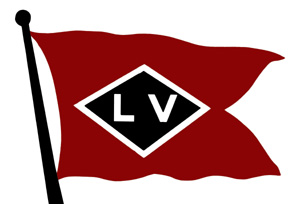 The Lehigh Valley Railroad (reporting mark LV) was one of a number of railroads built in the northeastern United States primarily to haul anthracite coal. It was authorized April 21, 1846 in the U.S. state of Pennsylvania and incorporated/established on September 20, 1847 as the Delaware, Lehigh, Schuylkill and Susquehanna Railroad Company. On January 7, 1853, the name was changed to Lehigh Valley Railroad. It was sometimes known as the Route of the Black Diamond, named after the anthracite it transported. At the time, anthracite was transported by boat down the Lehigh River; the railroad was meant to be faster transportation. The railroad ended operations in 1976 and merged into Conrail that same year.
The Lehigh Valley Railroad (reporting mark LV) was one of a number of railroads built in the northeastern United States primarily to haul anthracite coal. It was authorized April 21, 1846 in the U.S. state of Pennsylvania and incorporated/established on September 20, 1847 as the Delaware, Lehigh, Schuylkill and Susquehanna Railroad Company. On January 7, 1853, the name was changed to Lehigh Valley Railroad. It was sometimes known as the Route of the Black Diamond, named after the anthracite it transported. At the time, anthracite was transported by boat down the Lehigh River; the railroad was meant to be faster transportation. The railroad ended operations in 1976 and merged into Conrail that same year.
During its existence, the Lehigh Valley Railroad used a rail line that later became known as the Lehigh Line in order for it to operate. The Lehigh Line was the railroad's first rail line constructed which was built in 1855 between Easton, Pennsylvania and Allentown, Pennsylvania and it served as the main line for the Lehigh Valley Railroad. Serving as the main line for the Lehigh Valley Railroad, the rail line expanded past Allentown to Buffalo, New York and past Easton to New York City, bringing the Lehigh Valley Railroad to these metro areas. During the early years, the line served as the body of the Lehigh Valley Railroad until the railroad either built more rail lines or railroads, acquired more rail lines or railroads, and merged other railroads into their system. The line was known as the Lehigh Valley Mainline during the majority of its time under the ownership of the Lehigh Valley Railroad, starting in the 1930s. The "Lehigh Valley" was absorbed along with several northeastern rail lines into Conrail; the main line became known as the Lehigh Line during the Conrail ownership. Conrail shortened the track miles by abandoning most of its route to Buffalo and some of the line entering New York City area. The Lehigh Line is now owned by the Norfolk Southern Railway.
As of 31 Dec 1925, 1363.7 miles of road, 3533.3 miles of track; as of 31 Dec 1970, 927 miles of road and 1963 miles of track.
From Wikipedia

During its existence, the Lehigh Valley Railroad used a rail line that later became known as the Lehigh Line in order for it to operate. The Lehigh Line was the railroad's first rail line constructed which was built in 1855 between Easton, Pennsylvania and Allentown, Pennsylvania and it served as the main line for the Lehigh Valley Railroad. Serving as the main line for the Lehigh Valley Railroad, the rail line expanded past Allentown to Buffalo, New York and past Easton to New York City, bringing the Lehigh Valley Railroad to these metro areas. During the early years, the line served as the body of the Lehigh Valley Railroad until the railroad either built more rail lines or railroads, acquired more rail lines or railroads, and merged other railroads into their system. The line was known as the Lehigh Valley Mainline during the majority of its time under the ownership of the Lehigh Valley Railroad, starting in the 1930s. The "Lehigh Valley" was absorbed along with several northeastern rail lines into Conrail; the main line became known as the Lehigh Line during the Conrail ownership. Conrail shortened the track miles by abandoning most of its route to Buffalo and some of the line entering New York City area. The Lehigh Line is now owned by the Norfolk Southern Railway.
As of 31 Dec 1925, 1363.7 miles of road, 3533.3 miles of track; as of 31 Dec 1970, 927 miles of road and 1963 miles of track.
From Wikipedia
Brand/Importer Information:  Formerly located in Cresskill, New Jersey, the now defunct Bev-Bel Corp. was founded by the late Irvin and Beverly Belkin in 1956. A prolific "boutique" producer of after-market, limited production, special run rolling stock and locomotives (in road names and non-traditional commemorative and holiday themed paint schemes that were not typically offered by the major manufacturers), Bev-Bel' sourced its models from Atlas Tool Co., Inc., Atlas Model Railroad Co., Inc., Bachmann, and Life-Like Trains.
Formerly located in Cresskill, New Jersey, the now defunct Bev-Bel Corp. was founded by the late Irvin and Beverly Belkin in 1956. A prolific "boutique" producer of after-market, limited production, special run rolling stock and locomotives (in road names and non-traditional commemorative and holiday themed paint schemes that were not typically offered by the major manufacturers), Bev-Bel' sourced its models from Atlas Tool Co., Inc., Atlas Model Railroad Co., Inc., Bachmann, and Life-Like Trains.

Manufacturer Information: 'Atlas Model Railroad' represents the New Jersey manufacturing facility for Atlas brand model railroad products. Atlas also imported European made models in their early years and those items will be noted as having manufacturers set appropriately. In the 1990s Atlas moved all their toolings to China.
Item created by: RoadRailer on 2017-02-02 15:07:27. Last edited by gdm on 2020-06-05 11:47:57
If you see errors or missing data in this entry, please feel free to log in and edit it. Anyone with a Gmail account can log in instantly.
If you see errors or missing data in this entry, please feel free to log in and edit it. Anyone with a Gmail account can log in instantly.


